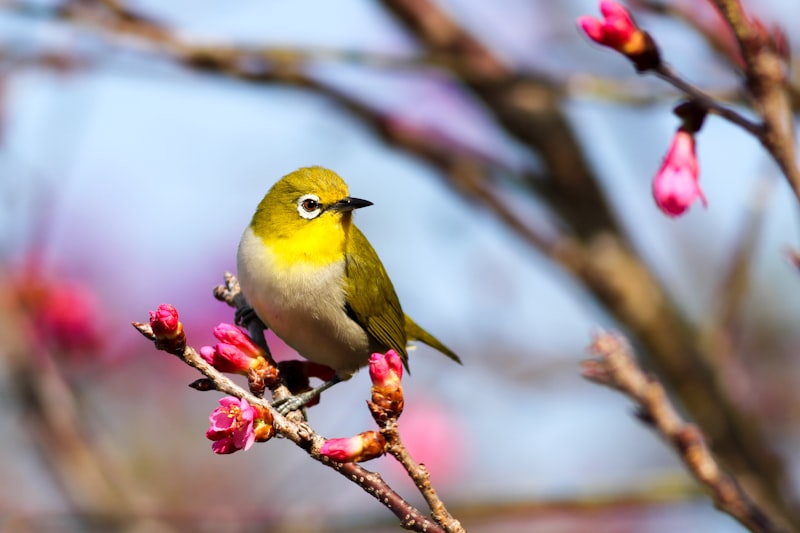Have you ever wondered how birds learn to sing or navigate thousands of miles during migration? It all boils down to their incredible neural mechanisms of learning. Birds possess complex brains that allow them to adapt and acquire skills crucial for survival and communication.
One fascinating aspect of avian learning is how they master their songs. Take the nightingale, for example. These birds learn their songs not from instinct but through a process akin to human learning. They listen to adult nightingales and practice their tunes until they perfect them. This learning process is governed by neural circuits in their brains that enable them to mimic and modify sounds, much like how we learn to speak.
Migration is another remarkable feat that showcases birds’ learning capabilities. Each year, millions of birds embark on long journeys, guided by an innate sense of direction but also learning from their environment. Studies have revealed that birds can learn and remember landmarks, wind patterns, and even celestial cues to navigate accurately across continents.
In the realm of neuroscience, researchers are delving deeper into these neural mechanisms. They’ve discovered that areas of the avian brain, such as the hippocampus and the basal ganglia, play crucial roles in spatial learning, memory consolidation, and motor skills acquisition. These brain regions are highly developed in birds known for their complex behaviors, underscoring the link between brain structure and learning abilities.
Understanding the neural mechanisms of learning in birds not only sheds light on their evolutionary adaptations but also provides insights into our own cognitive processes. By studying how birds learn, scientists hope to unravel fundamental principles of learning and memory that may apply universally across species, including humans.
Birds continue to inspire awe with their learning abilities, reminding us that intelligence comes in many forms across the animal kingdom.
Avian Intelligence Unveiled: Exploring Neural Pathways of Bird Learning
Birds have long been underestimated in terms of their cognitive abilities. However, recent research has unveiled a world where birds exhibit learning behaviors that rival some mammals. From problem-solving to tool usage, these feats highlight the intricate neural processes at work within their brains.
At the core of avian intelligence are specialized neural pathways that enable learning and adaptation. Unlike mammals, birds have a different brain structure, with a highly developed cerebrum and cerebellum. These regions are crucial for sensory perception, motor skills, and higher cognitive functions such as learning and memory.
One of the most intriguing aspects of bird learning is their ability to mimic sounds and even human speech. This phenomenon is rooted in their specialized neural circuits that process auditory information and coordinate complex motor movements required for vocalization.
Moreover, birds exhibit remarkable spatial memory, often navigating thousands of miles during migration with pinpoint accuracy. This feat is made possible by neural pathways that integrate visual cues, magnetic fields, and celestial navigation into a cohesive map-like representation in their brains.
In the realm of problem-solving, birds like crows and parrots have demonstrated exceptional intelligence. They can use tools to obtain food, solve puzzles to access rewards, and even exhibit social learning by observing and imitating others. These behaviors are supported by neural pathways that facilitate learning from experience and adaptability to changing environments.
Understanding avian intelligence isn’t just about appreciating their cognitive abilities; it also sheds light on our understanding of the evolution of intelligence itself. By studying the neural pathways involved in bird learning, scientists gain insights into how complex behaviors and cognitive functions can emerge in diverse species across the animal kingdom.
How Birds Learn: Unraveling the Neurological Wonders
Have you ever wondered how birds manage to learn such complex behaviors, from intricate songs to impressive flying maneuvers? The answer lies deep within their neurological wiring, showcasing a marvel of natural intelligence. Birds, ranging from the melodious nightingales to the agile falcons, exhibit fascinating learning abilities that continue to intrigue scientists worldwide.
At the core of avian learning is their remarkable brain structure. Birds possess highly developed neural pathways that facilitate learning and memory retention. Similar to humans, their brains consist of specialized regions that process sensory information and store learned behaviors. For instance, songbirds like the canary undergo extensive learning phases where they imitate tunes and develop unique songs through trial and error.
Neuroscientists have uncovered that birds exhibit both innate and learned behaviors, suggesting a blend of genetic predisposition and environmental influence. This dual mechanism allows them to adapt swiftly to their surroundings, mastering tasks such as foraging techniques or intricate flight patterns with astonishing agility.
Interestingly, studies reveal parallels between avian and human learning processes. Birds use repetition and reinforcement to solidify learned behaviors, akin to how humans acquire new skills. This cognitive flexibility enables them to thrive in diverse habitats, demonstrating a profound adaptation capability driven by their neural complexity.
Moreover, the study of avian learning extends beyond mere survival skills. Researchers explore how birds’ ability to mimic sounds or solve complex puzzles sheds light on fundamental principles of neuroplasticity and cognitive evolution. By unraveling these neurological wonders, scientists gain insights into enhancing human learning processes and treating cognitive disorders.
Inside the Bird Brain: Deciphering Neural Circuitry Behind Avian Learning

Ever wondered what makes birds such expert learners? It’s not just their songs or stunning aerial acrobatics; it’s the intricate workings of their brains. Let’s take a peek into the fascinating world of avian neural circuitry and how it shapes their ability to learn and adapt.
Bird brains, though small compared to ours, are marvels of efficiency. They are finely tuned for learning and processing information essential for survival. At the heart of this cognitive prowess are neural circuits, intricate pathways of nerve cells that enable birds to perceive, analyze, and respond to their environment.
One of the key regions in the bird brain responsible for learning is the hippocampus. This area plays a crucial role not only in spatial memory but also in learning new songs, behaviors, and even recognizing mates. Imagine it as the conductor in a symphony, orchestrating various brain functions to create harmonious learning experiences.
Avian learning isn’t just about imitating sounds or actions. It involves complex neural processes akin to our own learning mechanisms. When a bird learns a new song, for instance, specific neural circuits fire in sequence, strengthening connections that encode the song’s melody and rhythm. It’s like learning to play a musical instrument; practice strengthens neural pathways, making the skill more refined over time.
Researchers have long been fascinated by how birds learn from each other and from their environments. Studies show that certain species, like parrots and songbirds, possess brain structures optimized for vocal learning. These birds can mimic human speech or replicate intricate melodies with astonishing accuracy, showcasing the adaptability of their neural networks.
Understanding avian neural circuitry isn’t just about unraveling scientific mysteries; it offers insights into our own cognitive evolution. By studying how birds learn and adapt, scientists gain valuable clues about the fundamental principles of learning and memory across species.
Neuroscience of Bird Cognition: Mapping the Brain’s Learning Centers
Have you ever wondered how birds learn to navigate vast distances or mimic complex sounds? The neuroscience of bird cognition delves deep into understanding how avian brains process and learn information. At the core of this study lies the intricate mapping of the brain’s learning centers, revealing fascinating insights into avian intelligence.
Birds, despite their small brains relative to mammals, exhibit remarkable cognitive abilities. Researchers focus on mapping specific brain regions involved in learning and memory formation. One crucial area is the avian hippocampus, analogous to the human brain’s hippocampus, responsible for spatial navigation and memory consolidation. This structure enables birds like crows and parrots to remember precise locations of food caches or intricate flight paths over vast distances.
Moreover, the avian cortex, though different from the mammalian cortex in structure, plays a pivotal role in higher cognitive functions. It processes sensory information and coordinates complex behaviors like tool use observed in New Caledonian crows. This ability showcases not only their adaptability but also their sophisticated problem-solving skills.
Studies utilizing advanced neuroimaging techniques such as fMRI and electrophysiology have provided detailed maps of these brain regions, highlighting neuronal connections critical for learning and cognition. By understanding these neural circuits, scientists aim to unravel the evolutionary underpinnings of intelligence across species.
The neuroscience of bird cognition continues to astonish researchers with its revelations about avian intelligence. Through meticulous mapping of the brain’s learning centers, we gain profound insights into how birds navigate their environments, solve problems, and communicate. This ongoing exploration not only enhances our understanding of birds but also sheds light on the broader mechanisms of learning and memory in the animal kingdom.
This article is crafted to be engaging and informative, focusing on the fascinating aspects of bird cognition while maintaining SEO principles for readability and discoverability.
From Nestlings to Experts: Neural Mechanisms Driving Avian Mastery
Have you ever marveled at the remarkable abilities of birds, from their intricate songs to their unparalleled navigation skills? These feathered creatures, ranging from tiny nestlings to seasoned experts of the sky, owe much of their prowess to sophisticated neural mechanisms.
Birds’ brains are marvels of efficiency and adaptability. Despite their small size, avian brains are densely packed with neurons that enable them to perform complex behaviors. Take the example of songbirds, which learn their songs through a process akin to human language acquisition. This learning process involves specialized neural circuits that allow them to mimic and perfect intricate melodies.
Navigation is another area where birds shine. Species like homing pigeons can navigate vast distances with pinpoint accuracy, utilizing a combination of visual landmarks, magnetic fields, and even the position of the sun. These abilities are supported by specialized regions in their brains that process spatial information and integrate sensory inputs in real-time.
The development of these neural mechanisms begins early in a bird’s life. Nestlings are born with basic instincts but quickly learn from their environment. As they grow, their brains undergo remarkable plasticity, adapting to new challenges and refining their skills through practice and experience. This adaptability is crucial for their survival and success in diverse habitats.
Avian mastery is not merely a result of instinct but a product of ongoing neural development and learning. Each species has evolved unique adaptations that suit its ecological niche, demonstrating the incredible diversity and complexity of avian neuroscience.
Understanding these neural mechanisms not only sheds light on the evolutionary history of birds but also holds promise for applications in artificial intelligence and robotics. By studying how birds process information and solve complex problems, scientists can inspire new technologies that mimic nature’s efficiency and elegance.
The journey from nestlings to experts in the avian world is guided by intricate neural mechanisms honed through evolution. These mechanisms enable birds to master skills that continue to astound and inspire us, highlighting the extraordinary capabilities of the avian brain.
Flight School in the Brain: Insights into Bird Learning and Memory
Flight, central to a bird’s survival and lifestyle, isn’t merely a mechanical action but a symphony of neurological processes. At the core of this ability lies the avian brain, finely tuned by evolution to process complex spatial and navigational information. Imagine it as a flight school nestled within their neural circuitry.

Birds, from majestic eagles to nimble hummingbirds, undergo a remarkable journey of learning and memory formation. They don’t just flap their wings instinctively; instead, each flight involves a choreography of neural signals firing in synchrony. These signals navigate through specialized brain regions dedicated to flight, akin to classrooms where skills are honed and refined.
Neuroscientists marvel at how birds’ brains encode and recall flight-related information. Studies highlight neural pathways where sensory inputs—like visual cues and proprioception—are processed and integrated, facilitating precision in aerial maneuvers. It’s as if each bird attends a personalized flight school tailored by millions of years of evolutionary perfection.
Moreover, the memory aspect of avian flight is equally intriguing. Birds exhibit astonishing recall abilities, remembering intricate details of flight paths and feeding grounds across vast distances. This memory prowess isn’t just about survival; it’s about thriving in ecosystems where navigation and efficiency are paramount.
In essence, the concept of a “flight school in the brain” encapsulates more than just the mechanics of flight. It embodies the marvel of biological adaptation and the elegance of neural architecture honed by millennia of evolution. As we unravel these mysteries, we gain deeper appreciation for the avian world and the boundless capabilities of the bird brain.
Unlocking Nature’s Puzzle: Bird Brains and Adaptive Learning Strategies
Have you ever marveled at the intelligence of birds and their remarkable ability to adapt? Bird brains, despite their size, hold intricate secrets to survival in the wild. From complex problem-solving to innovative learning techniques, these feathered creatures continue to astonish scientists worldwide.
Birds, like humans, exhibit adaptive learning strategies that evolve with their environments. Take the New Caledonian crow, for example, known for fashioning tools from twigs to extract insects from tree bark. This behavior isn’t mere instinct; it’s a learned skill passed down through generations, demonstrating their cognitive flexibility.
One of the most fascinating aspects of bird cognition is their capacity for mimicry. Parrots, renowned for their ability to imitate human speech, showcase a form of adaptive learning that aids in their social interactions and survival. Their brains process and replicate sounds, showcasing a level of learning that’s both remarkable and complex.
In the avian world, problem-solving isn’t just a skill; it’s a survival strategy. Birds like the Eurasian jay can hide food in multiple locations and remember each stash months later. This adaptive behavior ensures their sustenance during lean times and highlights their cognitive prowess.
But how do birds accomplish such feats with brains far smaller than mammals’? The answer lies in their neural connectivity and efficiency. Bird brains are densely packed with neurons, allowing for rapid information processing and quick decision-making, crucial for navigating complex environments.
Understanding bird brains isn’t just about admiration; it offers insights into our own cognitive evolution. By studying their adaptive learning strategies, scientists gain a deeper understanding of neural plasticity and the potential for learning in diverse environments.
From tool-making crows to mimicking parrots, birds exemplify nature’s mastery of adaptive intelligence. Their ability to learn, innovate, and thrive in ever-changing habitats continues to inspire and intrigue researchers, unlocking the intricate puzzle of evolution’s most resilient learners.
Frequently Asked Questions
What are the key neural structures involved in bird learning
This FAQ provides a concise overview of the key neural structures involved in bird learning, focusing on their specific roles and contributions to avian cognition.
What role does song learning play in avian neural development
Understand the crucial role of song learning in avian neural development with our concise FAQ. Explore how this process shapes brain circuits and behaviors in birds.
How do environmental factors influence bird brain development
Learn how environmental factors impact bird brain development. Understand the crucial role of habitat, climate, and social interactions in shaping cognitive abilities and behavior.
How do birds use neural plasticity to learn new behaviors
Discover how birds utilize neural plasticity to learn new behaviors. This FAQ explores how their brains adapt and rewire through experience, enabling them to master complex skills such as song learning and tool use. Understand the mechanisms behind their ability to change and refine behaviors over time.
Can bird learning mechanisms be applied to human neuroscience research
Explore how bird learning mechanisms can be applied to human neuroscience research in this concise FAQ. Discover parallels in cognitive processes, neural plasticity, and behavioral studies that bridge avian and human neurological understanding.


